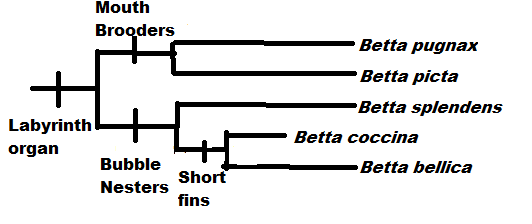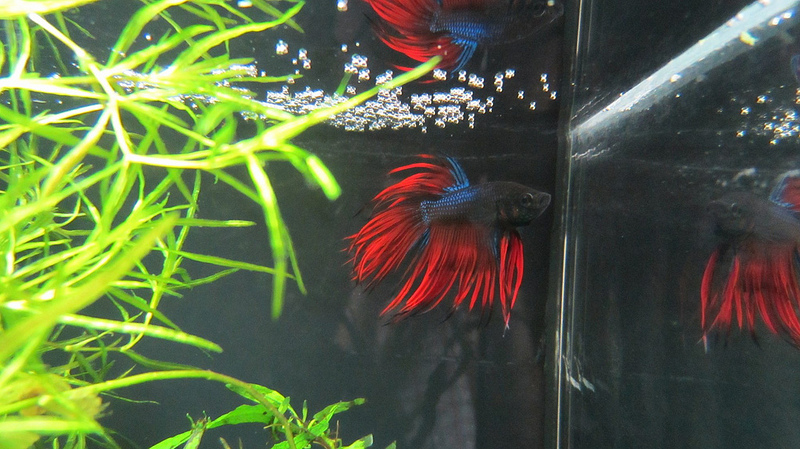Classification
Kingdom: Animalia
Phylum: Chordata
Class:
Actinopterygii
Order:
Perciformes
Family:
Osphronemidae
Genus:
Betta
Species:
splendens
Kingdom: Animalia
Species belonging to the kingdom Animalia are heterotrophs.
Heterotroph means they do not produce their own food, leading them
to find food elsewhere. Species in this kingdom are also described to
be multicellular, lack a cell wall, and
reproduce sexually (Woese et. al, 1990).
Phylum: Chordata
The most notable synapomorphy seen in the phylum Chordata is the
presence of a notochord. The notochord is a major structural element
in these species that emerges during embryonic development that is
important with structure, support, and communication (Myers, 2011).
Another feature is pharyngeal slits that, in fish, later develop
into gills which are used in gas exchange (Buchsbaum et. al, 1967).
Class: Actinopteryygii
The class Actinopterygii, also known as the “ray-finned fish” or
bony fish is described by fins that are supported by the presence of
long rayed bones, hence where the name comes from. In all the
different vertebrae groups, this one is one of the largest as well
as one of the most diverse as there are many different body plans
(Jonna, 2004).
Order: Perciformes
Looking at the fish that fall under the order of Perciformes
consists of
most of the common fish we are familiar with today in our nearby
lakes, rivers and streams. Perciformes literally means “perch-like.”
Fish in this order have many characteristics such as their fins, that
differ the Betta splendens from other fish. The pectoral fins of
these fish are located on the sides. Also, their dorsal and anal
fins are not only detached from the tail fin but also contain sharp
spines that can be used as a means of self-defense for the fish
(Weisz).
Family: Osphronemidae
The family Osphronemidae also known as Gourami, has one major
synapomorphy that divides the fish into a much smaller group. These
fish have been observed to express parental activity during
reproduction. In the reproductive process, the male fish builds a
bubble nest to hold the eggs. He holds domain over the nest and
protects the eggs. This action differs from the other fish species
that just swim over the eggs, releasing their sperm and continue on
their way (Ruber et. al, 2004).
Genus: Betta
The genus Betta has a very unique distinction caused by the presence
of a labyrinth. This organ allows them to breath in atmospheric air.
This allows these fish to live in shallow ponds, rice
patties, and other low oxygenated waters. Without this, these fish
would die in these habitats (Sturgeon, 2001).
Species: splendens
Lastly, the species splendens are separated by their means of
reproduction. Betta fish use bubble nests to host their
fertilized eggs until hatching. The other forms of Betta are
classified as mouth brooders. Mouth Brooders are described to have
developed differently from the betta fish as they adapted to the fast paces
of the stream life. This is compared to the shallow ponds and rice patties
the fighting fish are accustom to (Ruber et. al, 2004).
For more information on the Betta fish's classification go to Encyclopedia of Life. This site also has direct links to other species of Betta if interested in furthering research into these other species.

Figure 1. Represents the classification among different classes similar to Betta splendens. They are known as a Ray-Finned fish because their fins are supported by long-rayed bodies.

Figure 2. Represents the classification among the species similar to the Betta splendens. Betta splendens put their eggs in bubble nests unlike other Betta species that mouth brood. They also have much longer fins than species closely related to them.
Now let's examine the Betta fish's habitat. Click here to continue.
